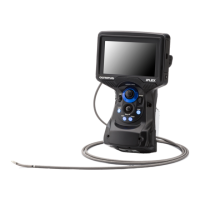Important Information — Please Read Before Use
9
EVIS LUCERA GIF/CF/PCF TYPE 260 Series OPERATION MANUAL
• The endoscope position detecting unit is designed only to
assist the insertion of an endoscope. Never insert the
endoscope into the patient’s body by observing only the
endoscope position display of the endoscope position
detecting unit. Be sure to observe the endoscopic image and
insert the endoscope while confirming the safety. If the
endoscope is inserted without observing the endoscopic
image, patient injury, bleeding, and/or perforation can result
(for CF-Q260DL/I, CF-H260DL/I only).
• Do not touch the light guide on the endoscope connector
immediately after removing it from the light source because it
is extremely hot. Operator or patient burns can result.
• When the endoscopic image does not appear on the monitor,
the CCD may have been damaged. Turn the video system
center OFF immediately. Continued power supply in such a
case will cause the distal end to become hot and could cause
operator and/or patient burns.
• When combining the endoscope with a splinting tube, there is
a risk of perforation or bleeding due to entanglement of the
mucous membrane, or of the tube to become separated from
the endoscope and remaining in the body. Before use, be
sure to read the instruction manual for the splinting tube to
fully understand its characteristics (for CF/PCF models only).
• Do not rely on the NBI observation mode alone for primary
detection of lesions or to make a decision regarding any
potential diagnostic or therapeutic intervention.
• During the endoscopic treatment, keep the insertion section
and the bending section as straight as possible. If there is a
loop or a bend on the insertion section or the bending
section, the operation can not be performed as intended, and
patient injury, bleeding, and/or perforation can result.
• Do not pull the universal cord during an examination. The
endoscope connector will be pulled out from the output
socket of the light source and the endoscopic image will not
be visible.
• Do not coil the insertion tube or universal cord with a
diameter of less than 12 cm. Equipment damage can result.
• Do not attempt to bend the endoscope’s insertion section
with excessive force regardless of its flexibility. Otherwise,
the insertion section may be damaged.

